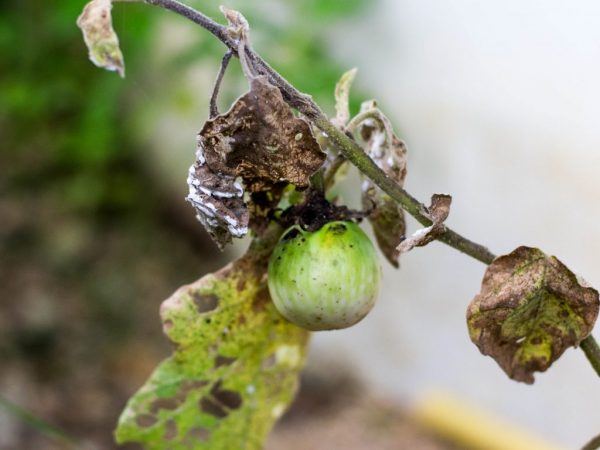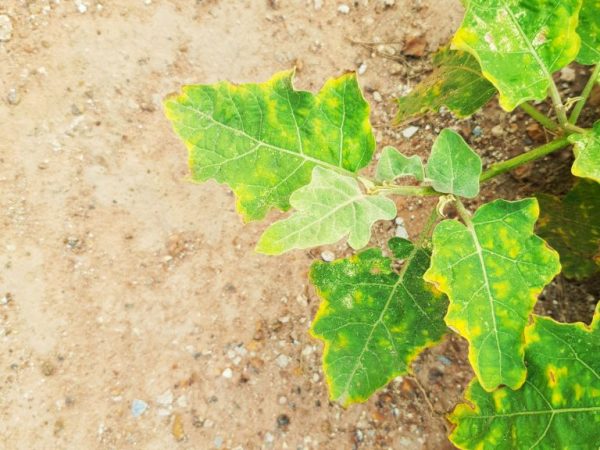Why do eggplant leaves turn yellow?
Among summer residents and gardeners, eggplant is a fairly popular crop that can be grown both in greenhouse conditions and in the open field. As practice shows, this vegetable is very whimsical in cultivation. Consider one of the most common problems, why eggplant leaves turn yellow and what to do about it.

Why do eggplant leaves turn yellow?
Causes of yellowing foliage
Unlike tomatoes and peppers, this plant has a delicate and thin stem, which makes it more difficult to grow a vegetable. Quite often, eggplant leaves turn yellow. Moreover, such a process takes place both in plants that grow in open ground and in those that are grown in greenhouse conditions. It is also bad that the yellowed foliage immediately falls off. Thus, the bare plant dies without having time to bloom and set fruits.
The reasons why the leaves of eggplant turn yellow:
- The most common reason for the yellowing of leaves in this crop is adaptation to a new growing area. The planted seedlings may turn yellow at first, and after some time after adaptation, their leaves return to their original green color.
- Leaf mosaic is a common disease that causes the leaves of eggplant to turn yellow. You can identify this sore by yellow spots on the surface of the foliage. The ripe fruits of such plants are very hard. This is the main reason for yellowing of leaves in greenhouse plants. Several factors can provoke the appearance of this problem and yellowing of the leaves: lack or excess of lighting, violation of its duration, as well as a sharp decrease in the temperature regime in the room. The same phenomenon is possible with seedlings grown on a windowsill.
- The leaves of greenhouse plants turn yellow due to a violation of agricultural technology. As horticultural practice shows, eggplants always turn yellow and wither in peat soil. For this culture, loamy or sandy loam soil is more suitable.
- Fusarium is another cause of yellowing of leaves in eggplant. Fusarium wilting is a very dangerous sore that can lead to the loss of all plantings. The causative agent of the disease first affects the vessels of the leaves, as a result of which they become discolored, then turn yellow, fall off. After them, shoots can wither and fall off.
- Verticillosis. This disease provokes wilting and yellowing of eggplants at all stages of growth, development and fruiting. The reason for this is the excess of applied fertilizers, in particular - nitrogen and organic matter.
- There is another reason why the lower leaves of eggplant turn yellow - this is a fungal disease. By the way, it is very easy to confuse it with fusarium, since the signs of these diseases are almost the same - the plants are covered with yellow spots. The fungus sits in the ground for a long time, then moves to plants. Moreover, such a pathogen affects both plants in the open field and plantings growing in a greenhouse. Signs: At first, the leaves turned yellow and then curled up into a tube.After a while, they dry out and fall off. Such bushes no longer have any chance of recovery and fruiting.
- If you notice that the lower leaves of the eggplant turn yellow, it is possible that you used already infected seed when planting.
- When growing this garden crop in a greenhouse, do not forget about the care that it requires. If you do not want to lose the grown bushes, ventilate the room regularly. Otherwise, infection with a fungal infection at high air humidity cannot be avoided, as well as yellowing of the foliage.
- Burns. Yellowness on the surface of the leaves can be caused by lighting devices in greenhouses. Outdoors, plants can turn yellow from the scorching sun. Therefore, it is necessary to irrigate and water the bushes only early in the morning or in the evening so that this does not happen.
- If the cotyledon leaves turn yellow and curl, then the plants lack nutrients. For full growth and development, this crop must be fed with nitrogen potash fertilizers. It is these two components that in many cases help to cope with the yellowness of the foliage.
- Eggplants, like other garden crops, require proper care. Untimely watering, soil overflow can also provoke massive yellowing of leaves on plants. This culture reacts very badly to watering with cold water - after that, its foliage begins to turn yellow.
In one case or another, fallen leaves should be disposed of immediately, since they are a source of infection infecting healthy leaves and plants.
Causes of yellowing seedlings

Yellow leaves from unfertilized soil
Let us find out why the leaves of eggplant seedlings in a greenhouse or on a windowsill turn yellow and dry. For this culture, it is very important to have adequate nutrition with macro- and microelements, as mentioned above. Due to the lack of nutrients in the soil, the upper leaves of the seedlings begin to suck out everything they need from the lower leaves. As a result, the cotyledon leaves turn yellow, wither or dry out.
In this case, it is very important to react in time and feed the plants with special seedlings. You can buy it at any specialty store.
The second reason for the yellowing of seedling leaves is the planting of infected material. Therefore, before planting eggplants for seedlings, the seeds should be disinfected with a solution of potassium permanganate.
Seedlings on the site turn yellow, possibly due to an excess of sunlight. Under the scorching sun, young plants not only turn yellow, but can also wither and dry out. Therefore, try to plant this crop in a garden bed protected from the scorching sun rays.
Why do fruits turn yellow?
The fruits of this plant can wither and turn yellow for various reasons:
- defeat by fungal, viral and bacterial infection;
- excess or lack of moisture in the soil;
- sunburn;
- acidification of the soil.
Helpful hints
After the cause of the yellowing of foliage and fruits is determined, this must be dealt with immediately:
- follow all the rules for planting seedlings (disinfect seeds, choose the right soil for planting seeds, choose a sunny site);
- to protect against fungus, the drug Trichomerdin must be added to the planting holes;
- carry out timely feeding with mineral and nitrogen-containing fertilizers in accordance with the dosage indicated on the package;
- water regularly in the morning and evening using warm water for irrigation;
- promptly remove diseased specimens from the site;
- regularly inspect plants for diseases;
- regular loosening and weeding will increase the air and moisture permeability of the soil, which will also help to avoid this problem.
Conclusion
Despite the fact that eggplant is a whimsical culture, you can avoid difficulties in growing it. If you follow the simple rules of agricultural technology and the above recommendations, the problem of yellowing, wilting and drying of leaves on plants can be avoided.


